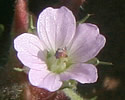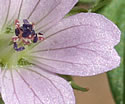Geranium bicknellii (Bicknell's Cranesbill)
| Also known as: | Northern Cranesbill |
|---|---|
| Genus: | Geranium |
| Family: | Geraniaceae (Geranium) |
| Life cycle: | annual |
| Origin: | native |
| Habitat: | sun; dry sandy or gravelly soil; gravel pits, rock outcrops, clearings |
| Bloom season: | May - September |
| Plant height: | 8 to 12 inches |
| Wetland Indicator Status: | none |
| MN county distribution (click map to enlarge): |  |
| National distribution (click map to enlarge): |  |
Pick an image for a larger view. See the glossary for icon descriptions.
Detailed Information
Flower: 
![[photo of flowers]](/udata/r9ndp23q/pd/geranium-bicknellii-7983-10-t.jpg) Flowers are about 1/3 inch across with 5 oblong to egg shaped petals, slightly notched at the tip, white to pinkish lavender with darker lines radiating from the base. The 5 sepals are oval-elliptic with a conspicuous sharp awn at the tip and are hairy on the outer surface; including the awn they are as long as or a little longer than the petals. Flowers are typically borne in pairs, each on a ¾ to 1 inch stalk (pedicel) that splits off at the tip of another ¾ to 1 inch stalk (peduncle) arising from the leaf axils and at the tips of growing branches. New flowers develop continuously through the growing season.
Flowers are about 1/3 inch across with 5 oblong to egg shaped petals, slightly notched at the tip, white to pinkish lavender with darker lines radiating from the base. The 5 sepals are oval-elliptic with a conspicuous sharp awn at the tip and are hairy on the outer surface; including the awn they are as long as or a little longer than the petals. Flowers are typically borne in pairs, each on a ¾ to 1 inch stalk (pedicel) that splits off at the tip of another ¾ to 1 inch stalk (peduncle) arising from the leaf axils and at the tips of growing branches. New flowers develop continuously through the growing season.
Leaves and stems: 




![[photo of leaves]](/udata/r9ndp23q/pd/geranium-bicknellii-7983-t.jpg) Leaves can be alternate but are mostly opposite on stalks up to 2 inches long. The blade is nearly round in outline, up to 3 inches across, hairy on both surfaces, deeply cleft into 5 (typical) fingerlike lobes that are generally wedge shaped at the base and fan out in their upper half, these lobes further lobed with rounded or blunt tips.
Leaves can be alternate but are mostly opposite on stalks up to 2 inches long. The blade is nearly round in outline, up to 3 inches across, hairy on both surfaces, deeply cleft into 5 (typical) fingerlike lobes that are generally wedge shaped at the base and fan out in their upper half, these lobes further lobed with rounded or blunt tips.
![[photo of stem, leaf node and stipules]](/udata/r9ndp23q/pink/geranium-bicknellii-bicknells-cranesbill_0927_171442-t.jpg) At the base of the leaf stalk is a pair of short, very narrow, sharply pointed, leafy appendages (stipules). Stems are sparsely hairy, spreading to erect with many ascending branches, spreading out to 3 feet across, and are often tinged red. Branches are swollen at the base, leaf stalks slightly so.
At the base of the leaf stalk is a pair of short, very narrow, sharply pointed, leafy appendages (stipules). Stems are sparsely hairy, spreading to erect with many ascending branches, spreading out to 3 feet across, and are often tinged red. Branches are swollen at the base, leaf stalks slightly so.
Fruit: 
![[photo of fruit]](/udata/r9ndp23q/pink/geranium-bicknellii-bicknells-cranesbill_0927_171425-t.jpg) Fruit is an erect capsule-like structure about 1 inch long with the persistent sepals around the base. In the center is a slender column divided into five sections, each attached at its base to an oval shaped carpel containing a single seed.
Fruit is an erect capsule-like structure about 1 inch long with the persistent sepals around the base. In the center is a slender column divided into five sections, each attached at its base to an oval shaped carpel containing a single seed.
![[photo of emptied carpels]](/udata/r9ndp23q/pink/geranium-bicknellii-bicknells-cranesbill_0731_123709-t.jpg) At maturity, the sections split apart from the base along the seams, causing the dried carpels to spring up and eject the seeds away from the mother plant.
At maturity, the sections split apart from the base along the seams, causing the dried carpels to spring up and eject the seeds away from the mother plant.
Notes:
The native Bicknell's Cranesbill can be distinguished from the non-native Siberian Cranesbill (Geranium sibiricum) by its 2 flowers per cluster and its narrower, more fan-like leaf lobes that have blunt or rounded tips. The leaf lobes of G. sibiricum are more broadly lance elliptic, have sharply pointed tips, and the flowers are nearly always single in the leaf axils on proportionately longer stalks. The native Carolina Cranesbill (G. carolinianum) also has 2 flowers per stalk but they are more densely clustered at the branch tips and are nearly stalkless, creating more of a flat-topped cluster. Distribution range can also be a good indicator. G. bicknellii is predominantly found in northern boreal forests where it responds to disturbances in forest openings, such as lumbering and fire. With only a few exceptions G. carolinianum is almost exclusively found in the western and southern prairie regions, especially in and around rock outcrops.
Native Plant Nurseries, Restoration and Landscaping Services ↓
More photos
 Bicknell's Cranesbill plant
Bicknell's Cranesbill plant Bicknell's Cranesbill plants, emerging from a clear cut
Bicknell's Cranesbill plants, emerging from a clear cut plants emerging following St. Louis River flood disturbance
plants emerging following St. Louis River flood disturbance more flowers
more flowers
Photos by K. Chayka taken in Carlton, Hubbard and Ramsey counties. Photos courtesy Peter M. Dziuk taken in Carlton County.
Comments
Have you seen this plant in Minnesota, or have any other comments about it?
on: 2015-11-16 11:47:44
I think we have these in woods behind our house and also in yard, but I don't see them on the MN County Distribution Map. Could it be a different geranium? Also, what does "adventive" mean? Thank you!
on: 2015-11-16 13:15:56
Susan: many plants, particularly non-native species, are under-reported in the state. Someone (even you) could collect a specimen and submit it to the Bell Herbarium for the official county records. A positive ID is required first, however. BTW, "adventive" is a species not native to MN (though could be elsewhere in the country) but is not yet completely naturalized. Populations tend to not spread far and wide like an invasive species would and may not even persist more than a few years.
on: 2017-07-05 13:30:41
Saw this up near Silver Creek - it was my first time seeing this flower, and your description of the number of flowers and length of stalks helped me distinguish it from similar tiny geraniums. It's so sweet and pretty. I only saw one, but I hope to see more!
on: 2018-08-20 20:13:43
Volunteering in flowerbeds with part sun, but not aggressively.
on: 2020-05-03 16:08:44
May 3, 2020. I just found this plant in my woods (oak and maples). Found in several areas. It is not blooming yet - but matches your overall description. Will go back and confirm when it blooms.
on: 2020-06-23 21:41:45
I'm finding them scattered throughout our property that was logged last summer.
on: 2023-08-20 19:05:33
Found the flower along side the bike trail between Madison Lake and Elysian today 8/20/23






